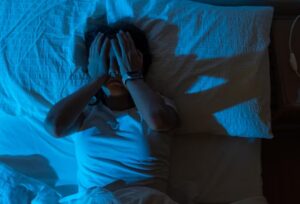Hypnic headaches, often referred to as “alarm clock headaches,” pose a unique challenge due to their nocturnal onset and distinctive features. These headaches typically manifest during sleep, abruptly waking individuals from their slumber. While the exact causes of hypnic headaches remain somewhat enigmatic, various factors have been proposed to contribute to their onset. In this comprehensive article, we delve into the causes, characteristics, treatment options, and associated factors of headaches.
 Potential Causes of Headaches: While the exact mechanisms underlying hypnic headaches are not yet fully understood, several theories about their origins have emerged:
Potential Causes of Headaches: While the exact mechanisms underlying hypnic headaches are not yet fully understood, several theories about their origins have emerged:
- Hyperactive Hypothalamus: An overactive hypothalamus, a crucial brain region responsible for various bodily functions, is believed to increase the likelihood of hypnic headaches. The disruption of the natural sleep-wake cycle by an overactive hypothalamus may trigger headaches during sleep phase transitions.
- Vasodilation and Blood Flow: Another theory attributes headaches to vasodilation—dilation of blood vessels—within the hypothalamus. Excessive excretion of carbon dioxide during sleep, known as hypocapnia, might cause increased pressure on the brain and spinal cord tissues, potentially leading to headaches.
- Gray Matter Abnormalities: A 2011 study published in the Annals of Neurology found that individuals experiencing hypnic headaches tend to have reduced gray matter in the brain. Gray matter houses neurons that regulate numerous central nervous system functions, including within the hypothalamic pain center.
Characteristics of Hypnic Headaches: The headaches have distinct attributes that differentiate them from other types of headaches:
- Timing: Hypnic headaches typically occur during sleep, awakening sufferers at a consistent time each night. These headaches commonly strike between 1 am and 3 am.
- Duration: These headaches are relatively brief, lasting between 15 minutes and an hour.
- Location: Pain associated with the headaches is often bilateral, affecting both sides of the head. The pain is typically described as throbbing or pulsating.
- Intensity: Although pain intensity varies, hypnic headaches are generally considered moderate in severity and rarely escalate to excruciating levels.
- Absence of Aura: The headaches generally lack the aura phase—a set of symptoms that can precede a migraine attack, such as visual disturbances or tingling sensations.
 Associated Health Factors: Several health factors have been linked to hypnic headaches:
Associated Health Factors: Several health factors have been linked to hypnic headaches:
- Age: Hypnic headaches are rare among infants, children, and young adults but are more prevalent among individuals over the age of 50.
- Gender: Cisgender women are approximately three times more likely to experience headaches than men.
- History of Headache Disorders: A notable connection exists between hypnic headaches and a history of other headache disorders. Up to 30-60% of individuals with it have reported experiencing migraines or other headache disorders in the past.
Hypnic Headache Treatment with Medication: Managing headaches often involves a combination of lifestyle adjustments and medication. While each individual’s response to treatment varies, several medication options have shown promise:
- Lithium: Commonly used for bipolar disorder, lithium can stabilize neurotransmitter activity and regulate the sleep-wake cycle, potentially reducing the frequency and intensity the headaches.
- Caffeine: The stimulant properties of caffeine can enhance blood flow and counteract vascular changes that may contribute to hypnic headaches. Its effectiveness varies and requires careful consumption.
- Indomethacin: This NSAID can reduce inflammation and alleviate vascular changes, potentially lessening the intensity and frequency of headaches.
- Melatonin: By adjusting sleep patterns, melatonin, a hormone regulating sleep-wake cycles, may help prevent the nocturnal onset of headaches.
- Calcium Channel Blockers: Medications like verapamil can regulate blood vessel activity, potentially reducing the likelihood of it.
 Hypnic headaches remain a fascinating area of study within primary headache disorders. While the exact causes continue to be explored, the unique characteristics, nocturnal timing, and potential treatment options underline the distinct nature of these headaches. As researchers and healthcare professionals advance their understanding, more effective management and treatment strategies are expected to emerge, offering relief to those who face the challenges of these distinctive nighttime headaches.
Hypnic headaches remain a fascinating area of study within primary headache disorders. While the exact causes continue to be explored, the unique characteristics, nocturnal timing, and potential treatment options underline the distinct nature of these headaches. As researchers and healthcare professionals advance their understanding, more effective management and treatment strategies are expected to emerge, offering relief to those who face the challenges of these distinctive nighttime headaches.






